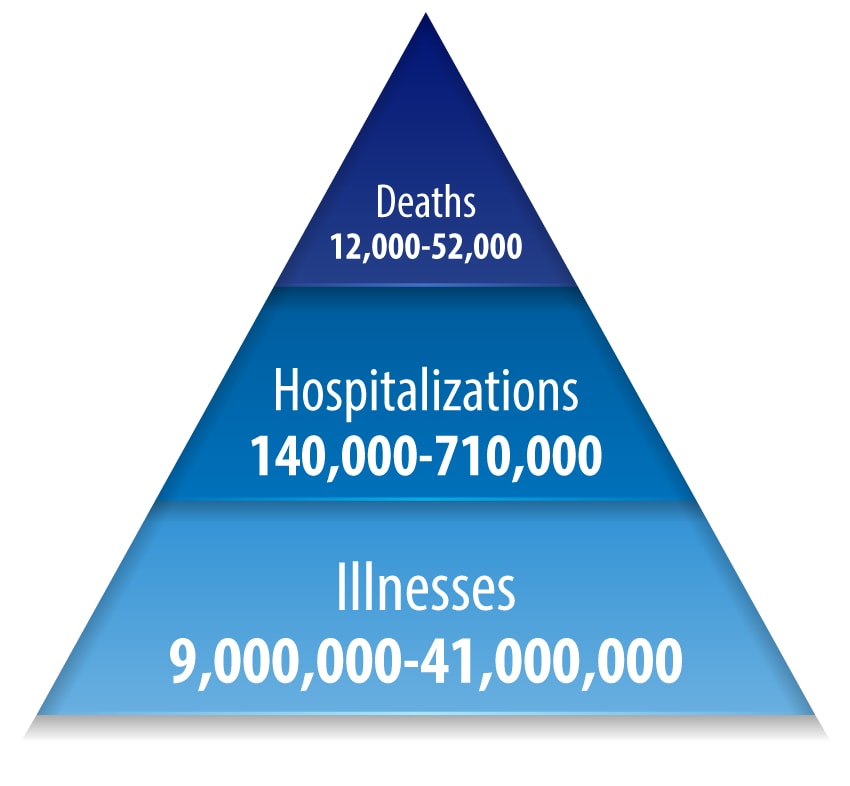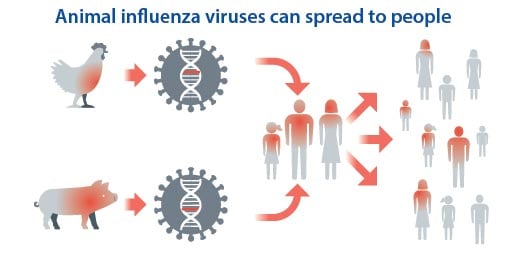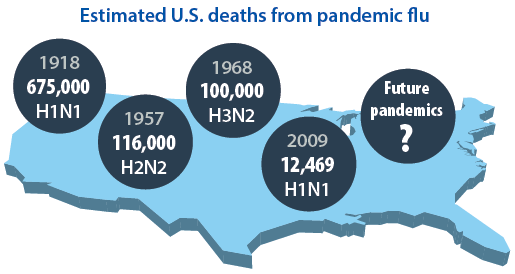Purpose
- Influenza poses one of the world's greatest infectious disease challenges.
- Flu is always changing, and novel influenza viruses are always emerging.
- CDC programs protect the United States from seasonal influenza and pandemic flu, which occurs when a new flu virus emerges that can infect people and spread globally.

Influenza is always changing
- Flu viruses change constantly, from season to season and sometimes during the season.
- Flu vaccines must be updated frequently
- Each year, influenza causes millions of illnesses, hundreds of thousands of hospitalizations, and tens of thousands of deaths.

Novel influenza viruses are always emerging
- Many kinds of influenza viruses spread in animals and are different from the 'seasonal' influenza viruses that normally spread in people.
- Influenza can spread in animals, especially in wild birds and pigs.
- A few animal influenza viruses can spread to people.
- More cases of animal flu viruses can spread to people.
- If a novel influenza virus spreads easily among people, and people have little immunity to it, a pandemic can occur.

An influenza pandemic can emerge anywhere and globally
- Four influenza pandemics have occurred in the past 100 years.
- The 1918-19 flu pandemic was the most severe:
- killing 675,000 Americans and 50 to 100 million people worldwide.
- During a pandemic:
- medicine may be in short supply
- vaccines may not be readily available
- hospitals may be overwhelmed
- schools and businesses may close

CDC protects Americans from influenza
Monitoring Influenza Viruses
Works with domestic and global health partners to monitor both human and animal influenza viruses to know what influenza viruses are circulating, where they are spreading, and what kind of illness they are causing.
Studying Influenza Viruses in the Laboratory
Studies both human and animal influenza viruses in the laboratory to better understand the characteristics of these viruses, including conducting genetic sequencing on more than 6,000 viruses each year.
Improving Testing and Diagnostic Tools
Develops and distributes tests and supplies materials to state, local, territorial, and international laboratories to detect and characterize influenza viruses.
Leading Influenza Planning and Preparedness
Supports state and local governments in preparing for the next influenza pandemic, including planning and leading pandemic exercises across all levels of government. CDC works with the World Health Organization (WHO) and partner countries in pandemic planning efforts. Domestically, CDC supports the development and use of community mitigation measures and medical countermeasures to minimize the impact of a pandemic.
Supporting Vaccine Development
Assists global and domestic experts who choose which viruses to include in seasonal vaccine production for each year’s vaccine and guides prioritization of pandemic vaccine development. CDC develops candidate viruses that manufacturers use to make flu vaccines. CDC tracks and monitors seasonal influenza vaccine distribution.
Funding and Technical Assistance
Provides direct support to state, local, and territorial public health departments for influenza surveillance and laboratory work. Globally, CDC supports more than 50 countries to build surveillance and laboratory capacity to find emerging influenza threats and respond to them.
Improving Tools to Prevent and Control
Evaluates the effectiveness of vaccines and drugs and updates recommendations on these.
Providing Timely and Accurate Information
Informs health care providers and public about influenza prevention and control measures. CDC works with businesses, schools, communities, and others to plan for and address influenza threats.
Background
CDC programs use scientific expertise and resources to protect the United States from the continuing threat posed by seasonal influenza (flu) and pandemic flu with the following activities:
- Monitoring and assessing influenza viruses and illness.
- Building and supporting surveillance and response capacity.
- Improving vaccines and other interventions.
- Applying research to enhance science-based prevention & control policies.
